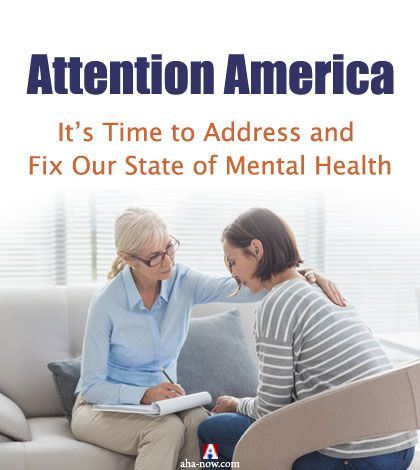Table of Contents
Let’s accept the fact that the state of mental health of many sections of our society is deteriorating. From children to teens and adults to seniors – there’s a growing trend of mental health disorders. Here’s an insight into the upcoming epidemic and things that we can do to fix it. ~ Ed.

Life’s tough. Surely, you have heard this phrase hundreds of times throughout your lifetime.
The fact of the matter, though, is that this is nothing new.
Although life has become more fast-paced over the past few decades, life hasn’t truly become more difficult. With the rise of technology and streamlines in various industries, these factors have actually made our lives easier.
Yet, the state of our collective mental health continues to deteriorate.
How? Why?
The problem is that more people simply aren’t coping with or don’t have the tools to cope with their issues.
While we are quick to address all physical health and material issues, we often tend to neglect our state of mental health.
Here’s a look at what mental health issues our young generation are suffering from and what needs to be done to fix those issues.
State of Mental Health: The Numbers
Take a look at the eye-popping figures regarding mental health. It is estimated that one in five people in the US lives with a mental health condition.
It’s not even a problem anymore. It’s an epidemic! What’s worse is that approximately 4% of the population will experience a mental illness within a given year.
This means that, on average, over the span of your lifetime, the overwhelming majority of US citizens will go through a mental break of sorts. And if this wasn’t enough to convince you of a national epidemic, take a look at the horrid state of mental health in elderly people.
If our senior citizens are suffering equally as bad as our general population, the case is further solidified.
Let’s take a look at the breakdown by demographic.
Related Posts
Children & Adolescence
According to the CDC, one in six children in the U.S. “had a diagnosed mental, behavioral, or developmental disorder.”
Keep in mind that these are only known cases and that there are surely other undiagnosed children throughout the country.
Teens
An unfortunate fact is that a large part of mass shootings in any given calendar year occur on high school campuses.
With teens being the most impressionable among the various age groups, this statistic, while frightening, isn’t shocking. However, it’s a growing trend with a significant cause for concern.
University Students
College-aged adults are likely only slightly less susceptible and vulnerable than high school teens. What’s more, is that mental health disorders on college campuses are more widespread than people understand.
And to make matters worse, it’s rarely spoken about while colleges say their resources are limited in dealing with the issues they face.
Today’s larger universities enroll over 50,000 students. Even smaller colleges can see upwards of 10,000 students. If we’re using the 20% figure from above, that means there are thousands of students living with mental health disorders.
Sadly, due to budgetary constraints, there are only so many psychologists that a university can employ. Online therapy with licensed professionals can be a possible solution, providing mental health services that are accessible, affordable, and convenient.
Adults
Adults clearly make up the largest part of the demographic. As such, it’s no surprise to see some of these statistics:
- Over 10 million adults with a substance abuse disorder have a co-occurring mental illness.
- Over 18% of adults experience an anxiety disorder.
- Over 1% of adults living with schizophrenia.
- 2.6% live with bipolar disorder.
- 16 million adults (roughly 7%) had at least one major depressive episode in the past year.
Various Groups Suffer
Aside from the breakdown by age, it’s important to note that several groups of people suffer as well. Mental illness does not discriminate.
U.S. veterans, for example, account for roughly 20 suicides per day. Transgender people see slightly higher suicide attempts over the general population. The homeless, many of whom don’t have the means to battle through their issues in an appropriate manner, suffer greatly.
Over 20% of prisoners (juveniles included), who oftentimes are denied access to quality healthcare, have a mental health condition.
Costs to Society
Yes, it’s true that our number one focus on why we should fix this problem is clear: to eradicate or at least control, an issue that causes devastating emotional and moral consequences. However, there are other (literal) costs to society as to why we should fix this issue quickly.
As per data gathered by NAMI, mental health costs the U.S. over $193 billion in annual lost earnings. Furthermore and on an individual level, in-office therapy sessions generally cost anywhere between $100-400, even with co-pay.
So while the government and state authorities lose out on tax revenue, individuals suffer out of pocket as well.
The Process Has Started, But Still a Long Ways to Go
While the above statistics paint the picture in an extremely negative light, it’s important to note that it’s not all doom and gloom.
Society has come a long way with regard to addressing the mental health issues our nation is facing. The stigma once associated with mental health is dwindling.
Various celebrities and athletes have spoken out about their own bouts with mental illness. This has already helped lay the foundation, showing people that it’s perfectly normal to seek out help and speak about their problems.
People have started telling friends and family that they’re seeing a therapist – something once unheard of. But, as implied, there’s still a long way to go. Remember, only 41% of adults with a mental health disorder in the U.S. received professional help over the past year.
However, the good news is that this mainly had to do with the fact that more than half the population, particularly in rural areas, doesn’t have access to a mental health professional. As such, we’re seeing licensed psychologists and therapists list their practice online while offering to counsel via the internet.
Although it’s early and we don’t have just enough data yet, results are encouraging. Telemedicine has contributed to fixing the state of our mental health.
Summing Up
You know the saying “the children are our future.” Well, let’s really take this to heart.
Given the above shocking statistics, we need to act fast as time is running out. The fact that over 17% of our children suffer from a mental disorder and that this is only a rough estimate, is outrageous and, quite frankly, terrifying.
We’re supposed to encourage and help better their development. We shouldn’t sit idly by and do nothing.
Furthermore, we have the responsibility to ensure our safety, morals and financial freedom going forward. But, it will take a collective effort. We cannot do this alone.
If you see someone suffering from a mental illness, encourage them to get professional help if no one else is doing so otherwise. As mentioned already, the stigma behind mental health is being eliminated each and every day. But, we all need to do our part, however small it may seem, it turns this ship around.
Over to You
Mental health has become a plague on our society. What are your thoughts on the matter? How do you think we can not only address properly but take care of the current mental health situation America is experiencing?
Photo Credit: wavebreakmedia
















I myself suffered badly when I was a university student. I did not know that I was suffering from Hypothyroidism. It completely destroyed my mental health. I could not get any help from anyone because nobody understood that fact. It was too late and my situation got worse. But there was no psychologist or psychiatrist in my university. But I came back sharply with the help of my mother and some counselling. And now I am writing about different health issues in my blogs :). I know the comment is big but I could not control it. There must a budget for the mental health related issues for the students Thanks for sharing such a nice post.